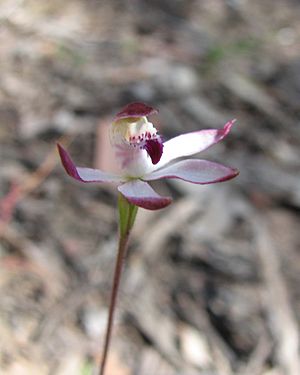Musky caps facts for kids
Quick facts for kids Musky caps |
|
|---|---|
 |
|
| Caladenia moschata growing in Glenlyon | |
| Scientific classification | |
| Genus: |
Caladenia
|
| Species: |
moschata
|
| Synonyms | |
|
Stegostyla moschata D.L.Jones |
|
The Musky Caps (scientific name: Caladenia moschata) is a special kind of orchid. People also call it the Musky Caladenia. It belongs to the amazing Orchid family! This plant is found only in eastern and south-eastern Australia, including Tasmania. It's a ground orchid, meaning it grows in the soil. Each plant has one leaf and can have up to five flowers. These flowers are usually dark on the back and white on the front. Sometimes, they have a little pink color. They also smell strongly like musk or soap! This plant used to be known by a different name, Caladenia gracilis.
What Do Musky Caps Look Like?
The Musky Caps orchid is a plant that grows from an underground part called a tuber. Think of a tuber like a small, round potato that stores food for the plant. These orchids can grow by themselves or in small groups.
Each Musky Caps plant has one leaf. This leaf is a bit hairy and can be about 90 to 180 millimeters (3.5 to 7 inches) long. It is usually 3 to 5 millimeters (0.1 to 0.2 inches) wide.
The plant grows a tall stem, about 150 to 300 millimeters (6 to 12 inches) high. On this stem, you can find up to five flowers. These flowers have a strong musky or soapy smell.
- Flower Colors: The front of the flower parts (sepals and petals) are white. They might have a touch of pink or bronze. The back of these parts has greenish-brown or purplish hairs.
- Flower Shape: The sepals and petals spread out sideways or point slightly downwards.
- The top sepal stands up straight. It is about 11 to 13 millimeters (0.4 to 0.5 inches) long. It curves forward, making a kind of hood over the center part of the flower called the column.
- The side sepals are about 14 to 16 millimeters (0.5 to 0.6 inches) long. The petals are a bit shorter, about 12 to 14 millimeters (0.5 inches) long.
- The Labellum: This is a special lip-like part of the orchid flower. It is about 7.5 to 9 millimeters (0.3 to 0.4 inches) long and 6 to 7 millimeters (0.2 to 0.3 inches) wide. It is white with red or purplish spots. The sides of the labellum are slightly wavy near the bottom. Closer to the tip, it has small teeth. The tip itself is strongly curled under and is pink.
- Calli: Along the center of the labellum, there are four rows of small bumps called calli.
- The Column: This is the central part of the flower. It has wide, rounded sides and reddish spots.
Musky Caps usually bloom in October and November. After the flowers, the plant grows oval-shaped seed pods. These pods are greenish or reddish and are about 10 to 14 millimeters (0.4 to 0.5 inches) long.
How Did Musky Caps Get Their Name?
The scientific name Caladenia moschata was officially given to this plant in 2008. It was named by a botanist named David Jones. The name was published in a special magazine called The Orchadian.
The second part of the name, moschata, comes from a Latin word. It means "perfumed with musk." This makes sense because the flowers have a strong musky smell!
Before 2008, this orchid was known as Caladenia gracilis. Some places, like the National Herbarium of New South Wales and the State Herbarium of South Australia, still use that older name.
Where Do Musky Caps Grow?
Musky Caps orchids are found in several parts of Australia. You can find them in New South Wales, Victoria, Tasmania, and South Australia.
These orchids like to grow in open forests. They are often found on dry ridges and slopes.
- In New South Wales, they grow in the southern areas, starting from the New England region.
- They are very common and widespread in Victoria and Tasmania.
- In South Australia, you can find them in the south-east corner. This includes areas near Millicent, Glencoe, and Wrattonbully.

